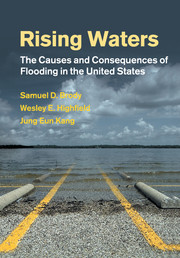1 - Introduction: rising waters
Published online by Cambridge University Press: 28 April 2011
Summary
On June 20, 2006, a heavy summer storm dumped over 10 inches (25.4 cm) of rain on the Houston, Texas, metropolitan area: several bayous overflowed and there were over 500 emergency calls for help from motorists stranded on flooded roads. On October 16 of the same year, only 6.5 inches (16.5 cm) of rainfall was enough to submerge a highway underpass leading to a major interstate under almost 12 ft (3.66 m) of water. As a consequence of the storm, schools closed and four people died when they became trapped in their cars. Three years later, in April 2009, the same amount of precipitation fell across Houston, once again flooding homes and major roads. This time, approximately 200 motorists were marooned in a parking lot, 80% of streets were under water in several neighborhoods, and five children were among those who died. This chronic pattern of flooding, property damage, and human casualties is not unique to Houston, but is replicated in thousands of towns and cities across the U.S. Rapid population growth in low-lying coastal areas, sprawling development patterns, and the alteration of hydrological systems are just three of the factors shaping the development of flood-prone communities in which more people are being placed at risk.
The little-known fact is that, among all natural hazards, floods pose the greatest threat to the property, safety, and economic well-being of communities in the U.S. More property is lost and more people die from flood events than from tornados, earthquakes, and wildfires combined.
- Type
- Chapter
- Information
- Rising WatersThe Causes and Consequences of Flooding in the United States, pp. 1 - 8Publisher: Cambridge University PressPrint publication year: 2011



